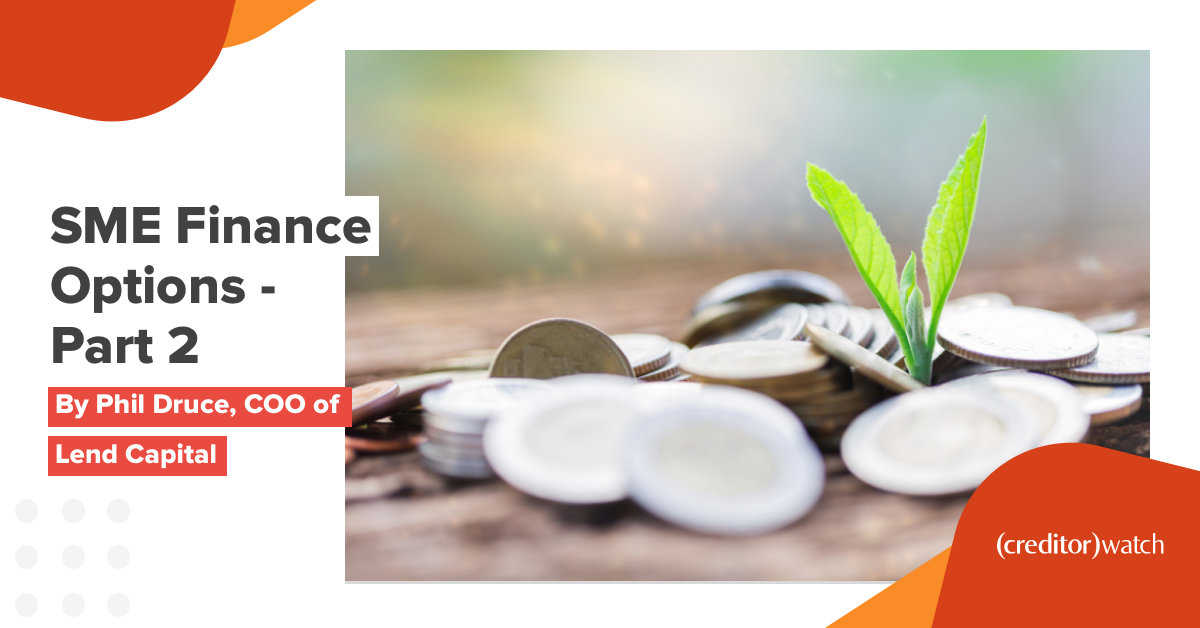Helping Australian small businesses navigate the sea of finance options
In Part Two of this two-part blog series, Phil Druce, COO of CreditorWatch customer Lend Capital, helps SMEs compare different business finance options for a range of situations.
In the first part of our series on SME Finance Options, we covered asset write-offs and government grants, along with some popular options for cash flow and how to start comparing your options.
In Part Two, we’ll look at securitised asset and equipment finance, and some alternative small business loan options for unique business situations. We’ll also cover some of the more detailed costs associated with business finance, including terms, rates, and fees to look out for.
Asset finance and other types of business finance
Asset finance
Asset finance is a business loan or lease arrangement between one and five years, which businesses use to fund the purchase of equipment, machinery or vehicles.
- The amount your business is approved for – and the term of the finance – will be directly tied to the cost and expected life span of the asset you want to buy.
- It is often quicker and easier to gain approval on equipment and asset finance than other types of business finance, as the loan is always secured by the asset you purchase.
- Equipment finance is available through banks and asset finance lenders. Specialist asset finance lenders will offer quick approval and an online application process.
If you missed out on the first part of our SME Finance series, you can find details about the $150,000 Instant Asset Write-off Threshold here.
Chattel mortgage
A chattel mortgage allows a business to take ownership of an asset – or ‘chattel’ – at the time of purchase. The lender advances funds to a business to purchase an asset – typically a vehicle – which the business then owns. With a chattel mortgage, the asset you purchase will always act as security on the loan.
Commercial Hire Purchase (CHP)
A Commercial Hire Purchase (CHP) allows a business to hire an asset from the lender instead of purchasing it outright.
The lender agrees to purchase the asset – such as a vehicle or piece of machinery – on behalf of the business, which will then hire the asset from the lender over a set period of time and for a fixed monthly repayment.
Finance lease
A finance lease enables a business to have both the use of business equipment and the benefits of ownership, while the lender retains actual ownership of the asset.
Similar to a CHP, the lender will purchase the asset on behalf of the business, which then pays the lender a fixed monthly lease rental for the term of the lease.
Operating lease
An operating lease – also called an Equipment Rental Agreement – is used when a lender agrees to purchase equipment on behalf of a business and rent it out over a period of time.
Like a finance lease or CHP, your business makes fixed monthly payments to use the asset, while the main difference is that you should be able to purchase the equipment from the lender at the end of the rental period.
Assets, depreciation and the ATO
The ATO provides extensive information and guidelines on purchasing assets, including how to calculate the total cost of your purchase, how to distinguish between business and personal use, and what happens if you want to start using assets that you personally own.
You can learn more about depreciation and business asset guidelines in detail here.
| Type of Finance | Ownership |
| Chattel Mortgage | Full ownership – Asset used as security on the loan |
| Commercial Hire Purchase | No ownership – Asset is purchased by the lender and leased to the business. |
| Finance Lease | Ownership benefits – Asset is purchased by the lender and leased to the business. |
| Operating Lease | Part ownership – Asset can often be purchased from the lender at the end of the term. |
Business credit card
A business credit card can be used for any business purpose, however they are ideal for making smaller purchases (in-store or online) or for paying bills (such as an unexpected tax bill) when your cash flow is fluctuating:
- Business credit cards tend to have interest-free periods – typically around 45 days – on most purchases.
If you can repay your full balance by the end of the interest-free period then you can avoid paying any interest at all, which can make this a very economical form of business finance – especially if you opt for a low-cost facility with no annual fees.
- Business credit card interest rates can be extremely high (possibly up to 20%)
Some credit card facilities also have very high fees (including set-up charges and ongoing admin fees) which can make them unsuitable if you aren’t regularly using them or are unable to repay the borrowed amount within the interest-free period.
- Business credit cards are sometimes coupled with reward schemes
Be sure to evaluate whether the value of the rewards to your business exceeds the cost – often, it won’t.
| Pros | Cons |
|
|
Invoice finance
Invoice finance – also known as ‘factoring’ – is different from other forms of business finance as it does not involve taking on debt. Instead, your business will sell outstanding customer invoices (accounts receivable) to a third party, known as a factoring company.
- You receive up-front payment from the factor (between 70% and 95% of the invoice)
- The factoring company collects payment from your customer
- The customer makes payment to the factor
- The factoring company will deduct their fee (around 3 – 5%) and transfer the remaining balance to you.
There are two types of invoice finance arrangements:
- A flexible ‘spot’ financing arrangement allows you to select which invoices you want to sell and when.
- A ‘full ledger’ financing agreement requires you to sell all invoices from a particular customer or over an agreed period.
There are also two types of factoring:
- Recourse factoring – you will need to buy back the invoice from the factoring company if the customer fails to pay – i.e. repay your advance amount. You will then be responsible for collecting payment from the customer.
- Non-recourse factoring – the finance company will take on the risk of non-payment if the customer fails to pay, and all you will lose is the remaining balance payment.
As the factoring company will assess the creditworthiness of your customers, not your own credit rating and trading history, factoring may be available to less-established businesses that do not qualify for other forms of business finance.
| Pros | Cons |
|
|
Merchant cash advance
A merchant cash advance is a type of finance used by businesses that make daily sales via credit card or EFTPOS. It is a type of short-term business loan generally between 1 – 12 months, which the business will repay in daily instalments (weekdays only) calculated on a percentage of its daily sales.
To qualify, your business will need to have a proven history of making a minimum average volume of sales. For merchant businesses with income that fluctuates from day to day and week to week, this business finance option can be far more convenient than making loan repayments on a fixed schedule.
However, merchant cash advances are often a very expensive form of business finance – interest rates can be as high as 200% APR – and lenders are free to impose restrictive conditions on your business as part of the loan terms.
| Pros | Cons |
|
|
Trade finance
Trade finance is a short-term finance solution you can use to reduce the risks involved in cross-border transactions, including bills of exchange, guarantees and letters of credit. In fact, according to a recent trade finance report by GetCapital, trade credit terms account for 10% to 40% of total SME assets.
Trade finance is especially useful if:
- You don’t have trusted trade partners
- You are dealing with unknown parties
- You are doing business in countries that have different legal systems and trade customs.
A financial institution will ensure payment is made, once they have proof that the goods have been shipped.
With some forms of trade finance, a lender will make an up-front cash payment to your business as soon as they have proof that the goods have been shipped, then collect payment from the buyer.
This is one of the biggest advantages of trade finance, as it ensures steady cash flow for your business and covers all the costs involved in manufacturing, storing and shipping items, even where the customer only pays on receipt of their goods.
| Pros | Cons |
|
|
Overview
| Type of Finance | Summary |
| Asset Finance | Finance using the purchased asset as security |
| Business Credit Card | A credit card designed to reward businesses |
| Invoice Finance | Receive upfront payment on invoices for a small fee |
| Merchant Cash Advance | A term loan which is repaid through merchant sales |
| Trade Finance | Short-term finance using an intermediary for sales payments |
How to compare your finance options
Start by thinking about the type of loan you’ll need. Do you need money for the short term or long term? Do you want a secured loan or an unsecured one? From there, you should be ready to have some conversations with potential lenders to find out which options are right for you.
Look at interest rates, fees and charges, terms and conditions as well as the lender’s reputation.
Terms
Long-term business loans (loans of three years or more) are often used for financing major business purchases, such as vehicles, assets, and equipment, and will generally require security by the lender. Here’s what you need to know about long-term business loans:
-
- Long-term finance facilities tend to have lower interest rates – but the interest compounds, and you’ll end up paying more interest overall than on a loan you repay more quickly.
- Some long-term facilities have break penalties, which means you could pay substantial fees if you wish to terminate them early.
- Many long-term business finance facilities require security – your lender will have a legal interest in any assets you offer as collateral for a secured loan, so you will no longer be able to sell or replace them without getting approval, which could be a slow or complicated process.
- Long-term finance facilities tend to have lower interest rates – but the interest compounds, and you’ll end up paying more interest overall than on a loan you repay more quickly.
Small business loans between 1 month and 3 years are often used by established businesses to cover sudden expenses – e.g. buying extra stock, paying a tax bill, or covering fluctuations in your revenue – and can be either secured or unsecured.
Rates
Choosing a rate for your loan will be one of your main considerations. We’ll discuss fees and other charges in the next section, but your main consideration with your rate will be a fixed or variable rate type:
- Fixed-rate loans are popular because they carry much lower risk than variable rates.
With a fixed loan, you’ll pay the same rate of interest for the life of the loan, regardless of what happens to the cash rate. However, this security tends to make them more expensive and less flexible than variable rates
- With a variable rate, your interest will fluctuate based on market values.
These fluctuations could be in your favour or not, but they are always a risk – even on a small loan amount, a change in rates could have a major impact on your cash flow. However, you can usually make extra payments on a variable loan, or even repay the entire debt early.
The type of rate you choose will depend on the lender you apply with, and should always be taken into account along with any fees or charges to determine an accurate cost of the loan. See a list of current business loan interest rates here.
Fees
If you want to calculate the true cost of a loan, you need to start with the advertised interest rate and include all fees which may be applicable:
- Set up fees
- Monthly fees or annual fees
- Transaction fees
- Penalty charges (e.g. for prepayment or late payment)
- Bonuses (such as initial periods of lower interest rates)
If any of these fees are added to your loan balance, you’ll also pay interest on them as well – this is a true cost of your loan, and is referred to as the comparison rate. Be sure to check your loan contract before agreeing to lender conditions, to ensure you won’t be liable for any unexpected charges or fees.
How to apply online
If you’re applying for a loan online, lenders will use your bank statements to quickly assess your level of risk as a borrower. It’s vital that your business bank statements are complete and unaltered. Lenders evaluate your business bank statements during the approval process to determine:
- Your business revenue
- Daily balance and monthly average
- Your ability to service the loan based on business revenue
- How much you can be approved for on a business loan
- The frequency of deposits and size of your customer base
- Any payments from the business to cover other debts or loans
Lenders need to review accurate and complete bank statements due to the risk in lending large amounts of money to small businesses.
Business loan lenders allow you to apply for a business loan online, and can automate the bank-statement analysis process, which enables them to provide faster approval on business loans, often within 24 hours.
Summary
Even during a pandemic, there is a range of finance options available from many different lenders. As the risks associated with lending increase, a wider pool of available sources to secure funding from can be crucial to business survival.
As technology continues to improve, and lenders have access to powerful bank-statement analysis technology, it’s easier for lenders to assess applicants, and easier for borrowers to get approved.
Having said that, banks often still offer the best rates, but generally only to businesses with a spotless credit record, a long and profitable trading history, and collateral to offer.
When considering the type of finance suitable for your business, speak to a financial advisor, and consider the rates and fees of your finance along with the term-specific use for your business loan:
- Interest rates and charges on short-term finance facilities are generally higher than long-term loans, so using these to fund long-term business needs is likely to be extremely expensive.
- Short-term finance can typically be cancelled at any time, so if you use it for major medium- or long-term purchases there is no guarantee that you’ll be able to find the funding you need to cover your outstanding borrowings once your loan expires.
- Long-term loans have lower interest rates, but compounding and the length of time it takes to repay the principal means you’ll pay a lot of interest in total.
There are often penalties for early termination, so if you use a long-term loan to finance a short- or medium-term need you could find yourself locked into an expensive arrangement which no longer suits your financial circumstances or business needs.
 Phil Druce
Phil Druce
Phil Druce, Chief Operating Officer (COO) of Lend Capital heads up technology and operations of the company.
He brings 20 years of experience in leadership of technology businesses. Since 2016, Phil has focused on producing technology-driven products and services and delivering exceptional client services for Lend.



